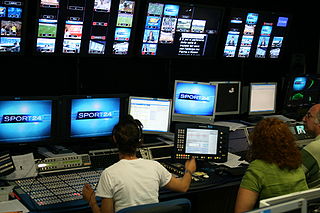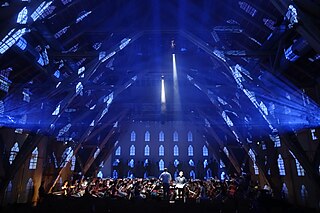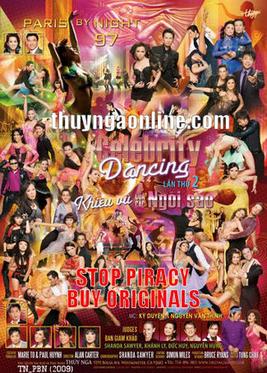
A film crew is a group of people, hired by a production company, for the purpose of producing a film or motion picture. The crew is distinguished from the cast, as the cast are understood to be the actors who appear in front of the camera or provide voices for characters in the film. The crew is also separate from the producers, as the producers are the ones who own a portion of either the film studio or the film's intellectual property rights. A film crew is divided into different departments, each of which specializes in a specific aspect of the production. Film crew positions have evolved over the years, spurred by technological change, but many traditional jobs date from the early 20th century and are common across jurisdictions and filmmaking cultures.
Video editing is the post-production and arrangement of video shots. To showcase perfect video editing to the public, video editors must be resonable and ensure they have a superior understanding of film, television, and other sorts of videography. Video editing structures and presents all video information, including films and television shows, video advertisements and video essays. Video editing has been dramatically democratized in recent years by editing software available for personal computers. Editing video can be difficult and tedious, so several technologies have been produced to aid people in this task. Overall, video editing has a wide variety of styles and applications.
An electrical lighting technician, or simply lighting technician, are involved with rigging stage and location sets and controlling artificial, electric lights for art and entertainment venues or in video, television, or film production.

A boom operator is a core role in the sound department of a film production, who works with the production sound mixer and utility sound technician. The principal responsibility of the boom operator is microphone placement, usually using a boom pole with a microphone attached to the end, their aim being to hold the microphone as close to the actors or action as possible without allowing the microphone or boom pole to enter the camera's frame.
A technical director (TD) is usually a senior technical person within e.g. a software company, engineering firm, film studio, theatre company or television studio. This person usually has the highest level of skill within a specific technical field.
Filmmaking or film production is the process by which a motion picture is produced. Filmmaking involves a number of complex and discrete stages, beginning with an initial story, idea, or commission. Production then continues through screenwriting, casting, pre-production, shooting, sound recording, post-production, and screening the finished product before an audience, which may result in a film release and exhibition. The process is nonlinear, as the director typically shoots the script out of sequence, repeats shots as needed, and puts them together through editing later. Filmmaking occurs in a variety of economic, social, and political contexts around the world, and uses a variety of technologies and cinematic techniques to make theatrical films, episodic films for television and streaming platforms, music videos, and promotional and educations films.
This is a list of episodes of In Bed with Medinner episodes in broadcast order, from broadcast series 2.

A television studio, also called a television production studio, is an installation room in which video productions take place, either for the production of live television and its recording onto video tape or other media such as SSDs, or for the acquisition of raw footage for post-production. The design of a studio is similar to, and derived from, movie studios, with a few amendments for the special requirements of television production. A professional television studio generally has several rooms, which are kept separate for noise and practicality reasons. These rooms are connected via 'talkback' or an intercom, and personnel will be divided among these workplaces.

The production control room (PCR) or studio control room (SCR) is the place in a television studio in which the composition of the outgoing program takes place.
Television crew positions are derived from those of film crew, but with several differences.
The set decorator is the head of the set decoration department in the film and television industry, responsible for selecting, designing, fabricating, and sourcing the "set dressing" elements of each set in a Feature Film, Television, or New Media episode or commercial, in support of the story and characters of the script. The set decorator is responsible for each décor element inside the sets, from practical lighting, technology, art, furniture, drapery, floor coverings, books, collectables, to exterior furnishings such as satellite dishes, Old West water troughs, streetlamps, traffic lights, garden furniture and sculptures.

The location manager is a member of the film crew responsible for finding and securing locations to be used, obtaining all fire, police and other governmental permits, and coordinating the logistics for the production to complete its work. They are also the public face of the production, and responsible for addressing issues that arise due to the production's impact on the community.

Video design or projection design is a creative field of stagecraft. It is concerned with the creation and integration of film, motion graphics and live camera feed into the fields of theatre, opera, dance, fashion shows, concerts and other live events. Video design has only recently gained recognition as a separate creative field. For instance, United Scenic Artists' Local 829, the union that represents designers and scenic artists in the US entertainment industry, only added the Projection Designer membership category in 2007. Prior to this, the responsibilities of video design would often be taken on by a scenic designer or lighting designer. A person who practices the art of video design is often known as a Video Designer. However, naming conventions vary around the world, and so practitioners may also be credited as Projection Designer, "Media Designer", Cinematographer or Video Director. As a relatively new field of stagecraft, practitioners create their own definitions, rules and techniques.

The Human Animal: A Personal View of the Human Species is a British nature documentary series written and presented by English zoologist Desmond Morris, first transmitted on BBC One in the United Kingdom from 27 July to 31 August 1994. It was co-produced in association with Discovery Communications in the United States, as well as several public broadcasters include: ORF in Austria, various ARD networks in Germany, and Teleac in the Netherlands.
Articles related to the field of motion pictures include:

Paris By Night 96 - Nhạc Yêu Cầu 2 is a Paris By Night program produced by Thúy Nga that was filmed at the Knott's Berry Farm on April 18, 2009 and April 19, 2009 and release DVD from June 25, 2009. The show was MC'ed by Nguyễn Ngọc Ngạn and Nguyễn Cao Kỳ Duyên.
Classic Whitney: Live from Washington, D.C., were live concerts by Whitney Houston.

Paris By Night 97 - Khiêu Vũ Của Các Ngôi Sao 2 is a Paris By Night program produced by Thúy Nga that was filmed at Knott's Berry Farm on April 22, 2009 and released onto DVD September 7, 2009. The show was approximately 5 hours and was MC'ed by Nguyễn Văn Thinh and Nguyễn Cao Kỳ Duyên.
A line producer is a type of film or television producer who is the head of the production office management personnel during daily operations of a feature film, advertisement film, television film, or TV program. A line producer usually works on one film or episode of a TV program at a time. They are responsible for human resources and handling any problems that come up during production. Line producers also manage scheduling and the budget of a motion picture, as well as day-to-day physical aspects of the film production.
Rhodesia Television (RTV) was a live-broadcast, television station operating in Southern Rhodesia (now Zimbabwe) as a private company. It was established on the 14th of November, 1960, first in Salisbury (now Harare), with transmissions in Bulawayo beginning seven months later. It was only the fourth TV service in Africa after Algeria, Nigeria and Egypt, and the first such service in southern Africa, since South Africa did not introduce television until 1976.








